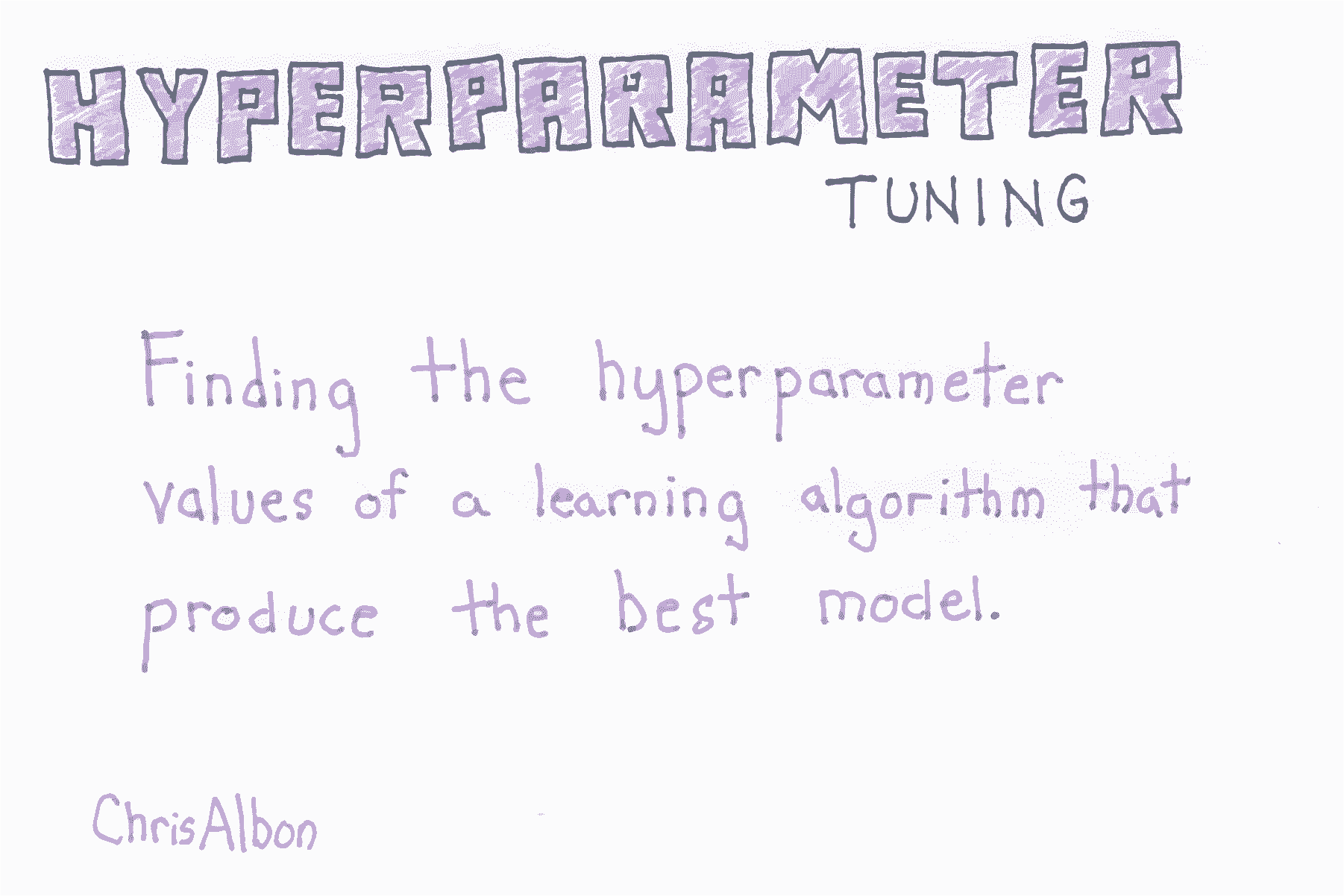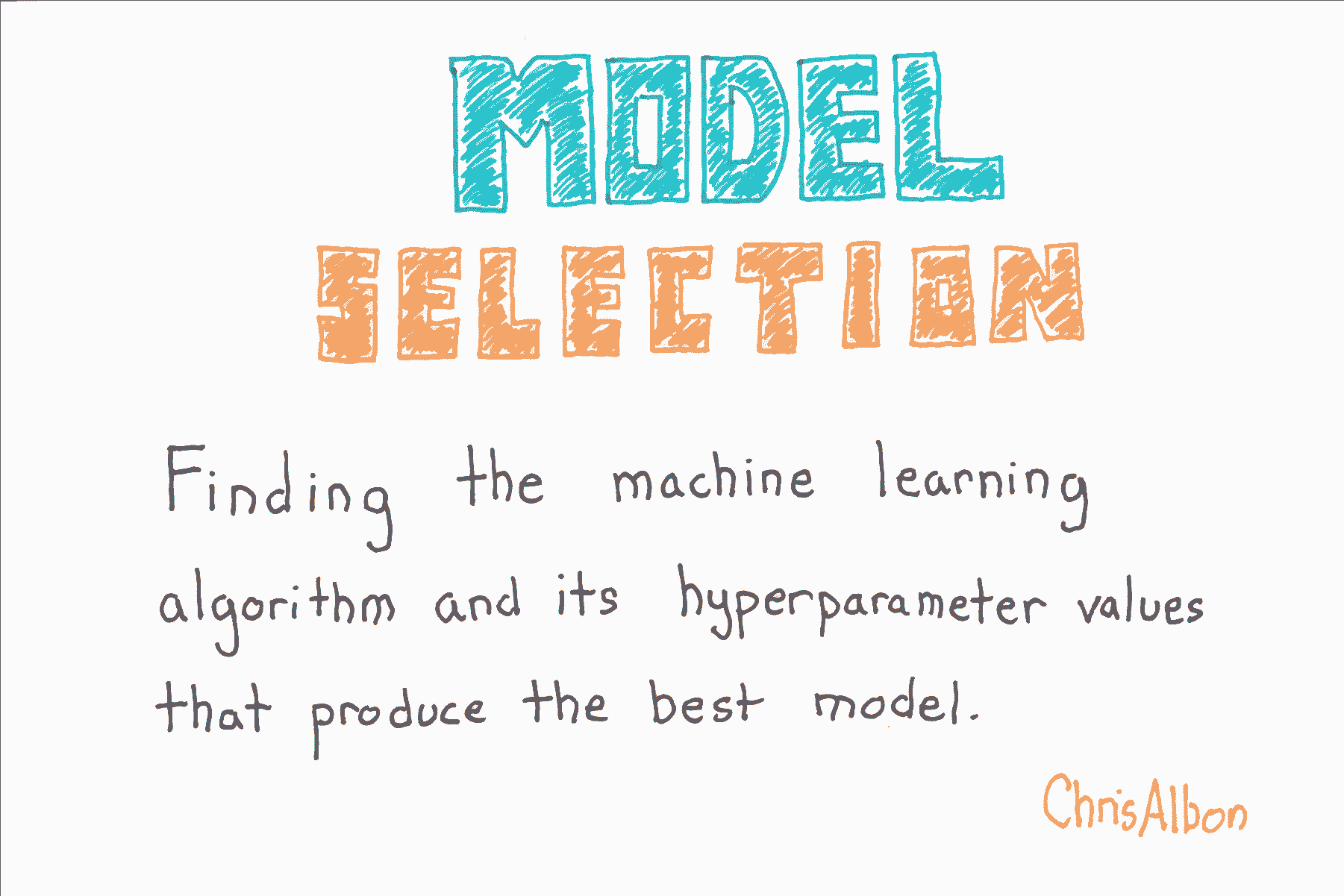十、模型选择
作者:Chris Albon
译者:飞龙
在模型选择期间寻找最佳预处理步骤
在进行模型选择时,我们必须小心正确处理预处理。 首先,GridSearchCV使用交叉验证来确定哪个模型表现最好。 然而,在交叉验证中,我们假装作为测试集被留出的一折是不可见的,因此不适合一些预处理步骤(例如缩放或标准化)。 出于这个原因,我们无法预处理数据然后运行GridSearchCV。
其次,一些预处理方法有自己的参数,通常必须由用户提供。 通过在搜索空间中包括候选成分值,可以像对待任何想要搜索其他超参数一样对待它们。
# 加载库
import numpy as np
from sklearn import datasets
from sklearn.feature_selection import SelectKBest
from sklearn.linear_model import LogisticRegression
from sklearn.model_selection import GridSearchCV
from sklearn.pipeline import Pipeline, FeatureUnion
from sklearn.decomposition import PCA
from sklearn.preprocessing import StandardScaler
# 设置随机种子
np.random.seed(0)
# 加载数据
iris = datasets.load_iris()
X = iris.data
y = iris.target
我们包括两个不同的预处理步骤:主成分分析和 k 最佳特征选择。
# 创建组合预处理对象
preprocess = FeatureUnion([('pca', PCA()), ("kbest", SelectKBest(k=1))])
# 创建流水线
pipe = Pipeline([('preprocess', preprocess), ('classifier', LogisticRegression())])
# 创建候选值空间
search_space = [{'preprocess__pca__n_components': [1, 2, 3],
'classifier__penalty': ['l1', 'l2'],
'classifier__C': np.logspace(0, 4, 10)}]
# 创建网格搜索
clf = GridSearchCV(pipe, search_space, cv=5, verbose=0, n_jobs=-1)
# 拟合网格搜索
best_model = clf.fit(X, y)
# 查看最佳超参数
print('Best Number Of Princpal Components:', best_model.best_estimator_.get_params()['preprocess__pca__n_components'])
print('Best Penalty:', best_model.best_estimator_.get_params()['classifier__penalty'])
print('Best C:', best_model.best_estimator_.get_params()['classifier__C'])
'''
Best Number Of Princpal Components: 3
Best Penalty: l1
Best C: 59.9484250319
'''
使用网格搜索的超参数调优

# 加载库
import numpy as np
from sklearn import linear_model, datasets
from sklearn.model_selection import GridSearchCV
# 加载数据
iris = datasets.load_iris()
X = iris.data
y = iris.target
# 创建逻辑回归
logistic = linear_model.LogisticRegression()
# 创建正则化惩罚空间
penalty = ['l1', 'l2']
# 创建正则化超参数空间
C = np.logspace(0, 4, 10)
# 创建超参数选项
hyperparameters = dict(C=C, penalty=penalty)
# 使用 5 折交叉验证创建网格搜索
clf = GridSearchCV(logistic, hyperparameters, cv=5, verbose=0)
# 拟合网格搜索
best_model = clf.fit(X, y)
# 查看最佳超参数
print('Best Penalty:', best_model.best_estimator_.get_params()['penalty'])
print('Best C:', best_model.best_estimator_.get_params()['C'])
'''
Best Penalty: l1
Best C: 7.74263682681
'''
# 预测目标向量
best_model.predict(X)
'''
array([0, 0, 0, 0, 0, 0, 0, 0, 0, 0, 0, 0, 0, 0, 0, 0, 0, 0, 0, 0, 0, 0, 0,
0, 0, 0, 0, 0, 0, 0, 0, 0, 0, 0, 0, 0, 0, 0, 0, 0, 0, 0, 0, 0, 0, 0,
0, 0, 0, 0, 1, 1, 1, 1, 1, 1, 1, 1, 1, 1, 1, 1, 1, 1, 1, 1, 1, 1, 1,
1, 2, 1, 1, 1, 1, 1, 1, 1, 1, 1, 1, 1, 1, 2, 1, 1, 1, 1, 1, 1, 1, 1,
1, 1, 1, 1, 1, 1, 1, 1, 2, 2, 2, 2, 2, 2, 2, 2, 2, 2, 2, 2, 2, 2, 2,
2, 2, 2, 2, 2, 2, 2, 2, 2, 2, 2, 2, 2, 2, 2, 2, 2, 2, 1, 2, 2, 2, 2,
2, 2, 2, 2, 2, 2, 2, 2, 2, 2, 2, 2])
'''
使用随机搜索的超参数调优
# 加载库
from scipy.stats import uniform
from sklearn import linear_model, datasets
from sklearn.model_selection import RandomizedSearchCV
# 加载数据
iris = datasets.load_iris()
X = iris.data
y = iris.target
# 创建逻辑回归
logistic = linear_model.LogisticRegression()
# 创建正则化惩罚空间
penalty = ['l1', 'l2']
# 使用均匀分布创建正则化超参数分布
C = uniform(loc=0, scale=4)
# 创建超参数选项
hyperparameters = dict(C=C, penalty=penalty)
# 使用 5 折交叉验证和 100 个迭代
clf = RandomizedSearchCV(logistic, hyperparameters, random_state=1, n_iter=100, cv=5, verbose=0, n_jobs=-1)
# 拟合随机搜索
best_model = clf.fit(X, y)
# 查看最佳超参数
print('Best Penalty:', best_model.best_estimator_.get_params()['penalty'])
print('Best C:', best_model.best_estimator_.get_params()['C'])
'''
Best Penalty: l1
Best C: 1.66808801881
'''
# 预测目标向量
best_model.predict(X)
'''
array([0, 0, 0, 0, 0, 0, 0, 0, 0, 0, 0, 0, 0, 0, 0, 0, 0, 0, 0, 0, 0, 0, 0,
0, 0, 0, 0, 0, 0, 0, 0, 0, 0, 0, 0, 0, 0, 0, 0, 0, 0, 0, 0, 0, 0, 0,
0, 0, 0, 0, 1, 1, 1, 1, 1, 1, 1, 1, 1, 1, 1, 1, 1, 1, 1, 1, 1, 1, 1,
1, 2, 1, 1, 1, 1, 1, 1, 1, 1, 1, 1, 1, 1, 2, 2, 1, 1, 1, 1, 1, 1, 1,
1, 1, 1, 1, 1, 1, 1, 1, 2, 2, 2, 2, 2, 2, 2, 2, 2, 2, 2, 2, 2, 2, 2,
2, 2, 2, 2, 2, 2, 2, 2, 2, 2, 2, 2, 2, 2, 1, 2, 2, 2, 1, 2, 2, 2, 2,
2, 2, 2, 2, 2, 2, 2, 2, 2, 2, 2, 2])
'''
使用网格搜索的模型选择

# 加载库
import numpy as np
from sklearn import datasets
from sklearn.linear_model import LogisticRegression
from sklearn.ensemble import RandomForestClassifier
from sklearn.model_selection import GridSearchCV
from sklearn.pipeline import Pipeline
# 设置随机种子
np.random.seed(0)
# 加载数据
iris = datasets.load_iris()
X = iris.data
y = iris.target
请注意,我们包括需要搜索的多个可能的学习算法和多个可能的超参数值。
# 创建流水线
pipe = Pipeline([('classifier', RandomForestClassifier())])
# 创建候选学习算法和它们的超参数的空间
search_space = [{'classifier': [LogisticRegression()],
'classifier__penalty': ['l1', 'l2'],
'classifier__C': np.logspace(0, 4, 10)},
{'classifier': [RandomForestClassifier()],
'classifier__n_estimators': [10, 100, 1000],
'classifier__max_features': [1, 2, 3]}]
# 创建网格搜索
clf = GridSearchCV(pipe, search_space, cv=5, verbose=0)
# 拟合网格搜索
best_model = clf.fit(X, y)
# 查看最佳模型
best_model.best_estimator_.get_params()['classifier']
'''
LogisticRegression(C=7.7426368268112693, class_weight=None, dual=False,
fit_intercept=True, intercept_scaling=1, max_iter=100,
multi_class='ovr', n_jobs=1, penalty='l1', random_state=None,
solver='liblinear', tol=0.0001, verbose=0, warm_start=False)
'''
# 预测目标向量
best_model.predict(X)
'''
array([0, 0, 0, 0, 0, 0, 0, 0, 0, 0, 0, 0, 0, 0, 0, 0, 0, 0, 0, 0, 0, 0, 0,
0, 0, 0, 0, 0, 0, 0, 0, 0, 0, 0, 0, 0, 0, 0, 0, 0, 0, 0, 0, 0, 0, 0,
0, 0, 0, 0, 1, 1, 1, 1, 1, 1, 1, 1, 1, 1, 1, 1, 1, 1, 1, 1, 1, 1, 1,
1, 2, 1, 1, 1, 1, 1, 1, 1, 1, 1, 1, 1, 1, 2, 1, 1, 1, 1, 1, 1, 1, 1,
1, 1, 1, 1, 1, 1, 1, 1, 2, 2, 2, 2, 2, 2, 2, 2, 2, 2, 2, 2, 2, 2, 2,
2, 2, 2, 2, 2, 2, 2, 2, 2, 2, 2, 2, 2, 2, 2, 2, 2, 2, 1, 2, 2, 2, 2,
2, 2, 2, 2, 2, 2, 2, 2, 2, 2, 2, 2])
'''
带有参数选项的流水线
# 导入所需的包
import numpy as np
from sklearn import linear_model, decomposition, datasets
from sklearn.pipeline import Pipeline
from sklearn.model_selection import GridSearchCV, cross_val_score
from sklearn.preprocessing import StandardScaler
# 加载乳腺癌数据集
dataset = datasets.load_breast_cancer()
# 从数据集特征中创建 X
X = dataset.data
# 从数据集目标中创建 y
y = dataset.target
# 创建缩放器对象
sc = StandardScaler()
# 创建 PCA 对象
pca = decomposition.PCA()
# 创建逻辑回归对象,带有 L2 惩罚
logistic = linear_model.LogisticRegression()
# 创建三步流水线。首先,标准化数据。
# 其次,使用 PCA 转换数据。
# 然后在数据上训练逻辑回归。
pipe = Pipeline(steps=[('sc', sc),
('pca', pca),
('logistic', logistic)])
# 创建 1 到 30 的一列整数(X + 1,特征序号)
n_components = list(range(1,X.shape[1]+1,1))
# 创建正则化参数的一列值
C = np.logspace(-4, 4, 50)
# 为正则化乘法创建一列选项
penalty = ['l1', 'l2']
# 为所有参数选项创建字典
# 注意,你可以使用 '__' 来访问流水线的步骤的参数
parameters = dict(pca__n_components=n_components,
logistic__C=C,
logistic__penalty=penalty)
# 创建网格搜索对象
clf = GridSearchCV(pipe, parameters)
# 拟合网格搜索
clf.fit(X, y)
# 查看超参数
print('Best Penalty:', clf.best_estimator_.get_params()['logistic__penalty'])
print('Best C:', clf.best_estimator_.get_params()['logistic__C'])
print('Best Number Of Components:', clf.best_estimator_.get_params()['pca__n_components'])
# 使用 3 折交叉验证拟合网格搜索
cross_val_score(clf, X, y)